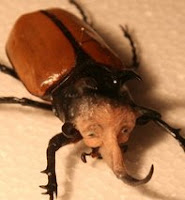 Note: This is the first article in a three part series. The other parts are A Brief Note on False Clues and A Family for Gregor.
Note: This is the first article in a three part series. The other parts are A Brief Note on False Clues and A Family for Gregor.Almost everyone, it seems, has encountered Kafka's dark tale of transformation in a high school or college lit. course. Most of us take it as truth that protagonist Gregor Samsa transforms in his bed into a giant cockroach. Indeed, representations of Samsa are universally in cockroach form. I made this tacit assumption for many years. It was not until I costumed a stage production of "The Metamorphosis" in college that I realized that nowhere in the text did the word "cockroach" actually appear. Now, here I must stop for a moment to confess that the words I was reading were not quite Kafka's own. As I do not understand German, I was utilizing various translations of the original text. I understand that much can be lost in translation. However, I am far from the first person to analyze "The Metamorphosis," and luckily for me many of those other folks spoke German. It's pretty clear that "cockroach" doesn't appear in any language. There exists an agreement among most translators that the word "ungeziefer,"(appearing in the first line of the book as what Gregor transforms into, and originally translated as "insect,") is in fact the word for "vermin," a much vaguer term. The German word for insect is the recognizable cognate, "insekt."
Putting aside for a moment the physical and behavioral descriptions Kafka gives of his protagonist, the first and only reference by a character in the book to Gregor being an insect is by the cleaning lady, relatively near the end of the story. She addresses him as "dung beetle," an oddly specific assertion that is not supported by the the book, as I will discuss in more detail later. There are never any such references on the part of the narrator.
All this got to nagging in the back of my brain. Is Gregor really a cockroach? And if he isn't, what is he? Thus I began to sift through the text, looking for hints in those physical and behavioral descriptions I asked you to put aside a paragraph ago. I would like to clarify that my aim here is not to deduce Kafka's intentions (I think it quite likely that the character was made deliberately vague), but rather to discern the possible classifications Gregor could be assigned while remaining scientifically accurate. As it turns out, cockroach is not among them.
To begin with, although never stated by the narrator, Gregor is an insect. Descriptions of his body (including segmentation, leg structure and properties, body structure and sensory organs) are not mutually consistent with any other creature.
Good. Now that its been narrowed down to a scant 30 million possible species, this should be a piece of cake.
My next step was to start with the easiest solution; could he really be a cockroach? Sadly, the easy answer didn't pan out. Unlike beetles (members of the order Coleoptera), cockroaches do not posses elytra (hardened wing-covers made of chitin). Post-transformation Gregor is described as having an "armour-hard back," a characterization that (while aptly depicting an insect in possession of elytra) would not apply to the bare-winged cockroaches.
Back to square one. Time to look at what there is to go on. Gregor is either a beetle or a so-called "true bug" (the two orders with elytra). He is brown in color, with a divided abdomen. He is flightless. (At one point his sister comments that, "he had to be somewhere or other, for he could hardly fly away.) He only feeds on rotten organic matter. Each of this things narrows down the possibilities, but the search for the real Gregor Samsa is certainly far from its conclusion.
So ends the first installment of my quest for the true identity of Gregor Samsa, a man burdened for so many years with the ill-fitting body of a cockroach. Stay tuned for chapter two!

No comments:
Post a Comment